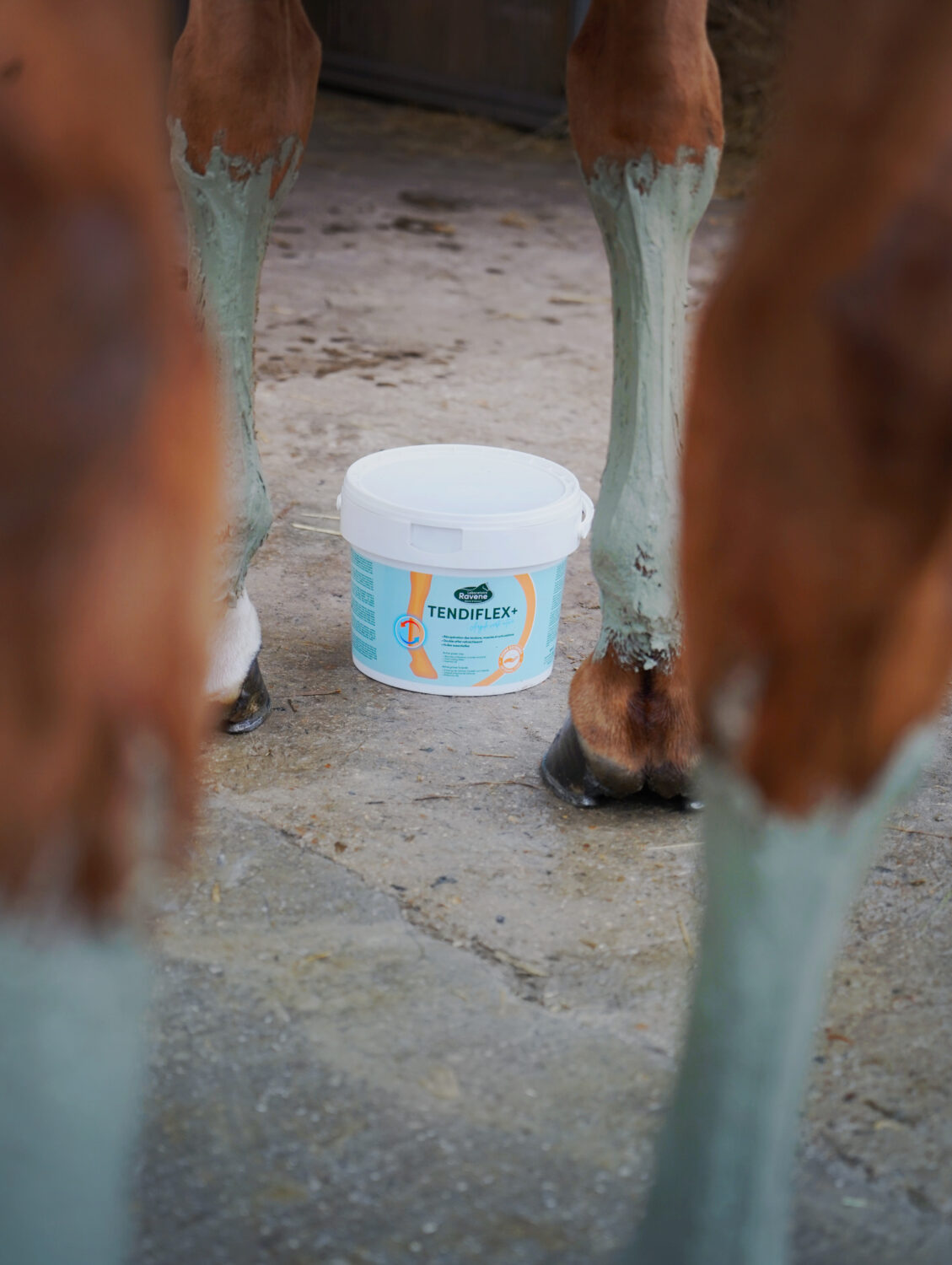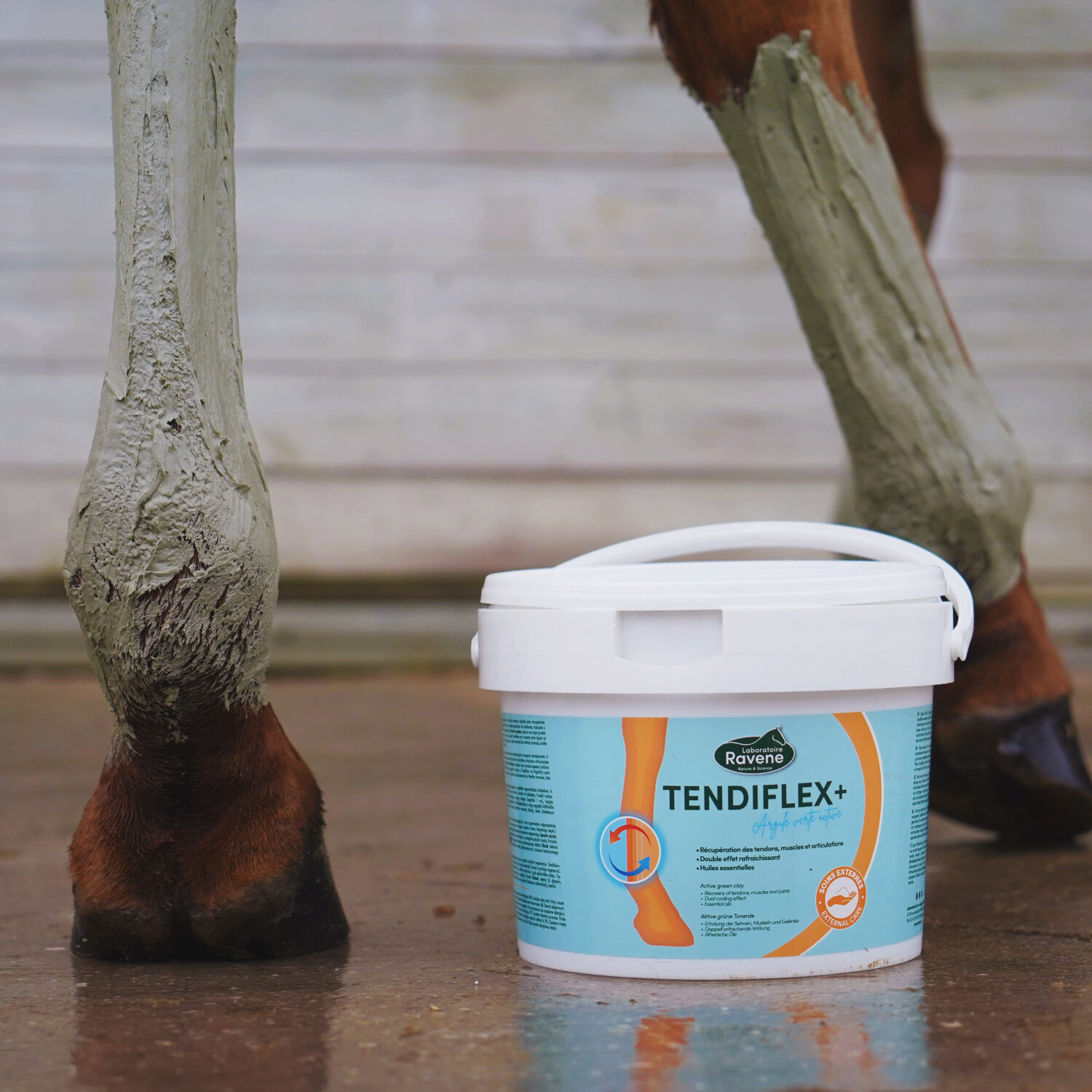“Tonight, I’m applying clay on his legs!”, “I’m going to rinse off the clay” …
As a rider, you probably have already heard such sentences spoken in stables. Indeed, clay poultice is one of the most common care product used by riders. Clay’s benefits are acknowledged since… Antic times! And if, back then, we only could observe the effects of clay for horses, without necessarily being able to explain them, we now know exactly how it operates! Actually, it is nothing more than basic physics and chemistry… For those hate or used to hate this topic in school, no worries, we’re going to keep it simple 😉

Clay, yes! But which one exactly?
There are multiple types of clay. It is more than ok to mix some different kinds of clay to attain the desired results. And it is this mix that is going to define the clay poultice’s color.
At Ravene, Tendiflex’s new formula is green clay. It is a mix of multiple types of clays: élite, Kaolinite, calcite as well as a 4th one, which we’re going to keep as a secret! These different clay types have been selected to gather in our formula all benefits that we are looking for our horses.

How does clay work?
- A great absorption capacity
Like a sponge, clay has an amazing intra-tissular absorption capacity. Some clays can absorb up to 40% of their weight in liquids! Applied to our horses’ legs after a training or show, clay can get rid of all toxins and other harmful substances.
- Particle transfer, both ways
If we know that clay absorbs some elements, we also are aware that the particle transfer from clay to the organism goes both ways. It could be that clay has a “re-mineralizing” effect, even though that would still need to be scientifically proven.
- Astringent properties: tightens tissues
Thanks to the absorption of toxins and other elements, clay helps in tightening tissues that tend to inflame, for instance during an intense effort.

In which circumstances should I apply clay poultice on my horse?
The various effects of clay on horses as an external care product make it be a perfect ally for the post effort recovery phase. Whatever your disciple is, you will help your horse to recover more quickly after an intense training session or show, by applying clay on the relevant areas. By the way…
On which of my horse’s areas can I apply clay poultice?
As we have just seen, clay has an intra-tissular action. It thus can be applied to the horse’s muscles, tendons, and joints.
However, clay poultice is mainly used on the horse’s tendons, as they are a very sensitive area that gets particularly challenged during efforts. It can thus be useful in case of tendonitis – of course, in addition to a veterinary protocol.
On the other body parts, it can also be used in case of bruises, sprains, or various contusions.
It is also possible to apply a clay poultice on muscular areas that are being challenged by the exercise, or according to the horse’s physical weaknesses (back, loins, neck, shoulders…).

How to apply clay poultice on your horse?
Application
The best is to first apply the poultice against the grain, as to get the product as close to the horse’s skin. Then, apply another layer in the hairs’ grain, to even out the surface. It is important to apply a thick layer (1cm) to maximize efficiency.
You can leave the poultice that way to air dry or add leg bandages by protecting them with newspaper material or plastic film.
Length
There is no ideal length for the application of clay poultice. What is important is for the clay to have enough time to dry before rinsing it off, as it is by drying that its effects occur. That is why it is common to apply clay in the evening to be taking it off the next morning.
If you are not able to rinse off the clay in the morning – because you usually go to work and then go to see your horse in the evenings, for instance – there is no need to worry! You can absolutely leave it on for 24h, as it will not have any consequences. Once the clay is dry, it simply does not have any effect left.
Removal process
It’s the easy part! With a bit of water or thanks to a brush… (go easy with the brush on the tendons). By the way, Tendiflex’s new formula is super easy to remove!
To conclude: what are the benefits of clay poultice?
Personally, I am a big fan of clay!
Why, may you ask? Well, simply because clay is a very easy product to use. On the tendons, it allows you to avoid using bandages. They are difficult to put on, and their use can be risky they are put on wrong, or if your horse manages to catch them and tries to pull on them…
It is also an ideal solution for horses living in the field, that can simply not benefit from the use of bandages. A bit of clay on the legs when coming back from the show, and in the field, we go!
As I have a horse that strongly reacts to the smallest bruise or impact, it is a great help!
And, at the time of sustainability and natural care… Is there really anything better than using nature’s benefits to take care of our beloved horses?
Thank you for reading,
Amélie







